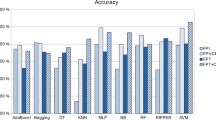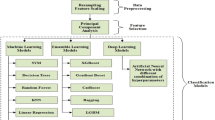Abstract
Parkinson’s disease (PD) is a prevalent problem among old people above the age of 60 years. It is a neurological disorder which affects the dopamine-producing neurons, which are situated in a part of the human brain called the substantia nigra. Although the aetiology of PD is still unknown, the symptoms appear gradually with age. As the disease progresses, patients may face difficulty with normal motor functions such as walking. They may also witness change in behaviour, undergo mental health problems which might lead to depression, memory loss and fatigue. This paper deals with application of classification algorithms to bridge the gap between medical sciences and artificial intelligence. The fine-tuned model promised an accuracy of 94% on classifying new, undiagnosed patients with a recall of 100%, diminishing chances of misclassification which were prevalent in other researches.
Access this chapter
Tax calculation will be finalised at checkout
Purchases are for personal use only
Similar content being viewed by others
References
Revett K, Gorunescu G, Mohamed S (2009) Feature selection in Parkinson’s disease: a rough sets approach. In: Proceedings of the international multi conference on computer science and information technology, IMCSIT’09, vol 4, pp. 425–428
Ramani R, Sivagami G (2011) Parkinson Disease classification using data mining algorithms. Int. J. Comput. Appl. 32(9):17–22
Bind S, Tiwari A, Sahani A (2015) A survey of machine learning based approaches for Parkinson disease prediction. Int J Comput Sci Inf Technol 6(2):1648–1655
Ene M (2008) Neural network-based approach to discriminate healthy people from those with Parkinson’s disease. In: Annals of the University of Craiova—Mathematics and computer science series, vol 35, pp 112–116
Ozcift A, Gulten A (2011) Classifier ensemble construction with rotation forest to improve medical diagnosis performance of machine learning algorithms. Comput Meth Programs Biomed 104(3):443–451
Can M, Sciences N (2014) Boosting committee machines to detect the Parkinson’s disease by neural networks
Das R (2010) A comparison of multiple classification methods for diagnosis of Parkinson disease. Expert Syst Appl 37(2):1568–1572
Paper C, Caglar MF, Cetisli B (2009) Automatic recognition of parkinson disease from sustained phonation tests using ann and adaptive neuro-fuzzy classifier automatic recognition of Parkinson’s disease from sustained phonation tests using ANN and adaptive neuro-fuzzy classifier Yapay Sini, Oct 2016
Introduction to boosted trees—xgboost 1.3.0-SNAPSHOT documentation (2020). https://xgboost.readthedocs.io/en/latest/tutorials/model.html
UCI Machine Learning Repository (2020) Parkinsons data set. https://archive.ics.uci.edu/ml/datasets/parkinsons
Author information
Authors and Affiliations
Corresponding author
Editor information
Editors and Affiliations
Rights and permissions
Copyright information
© 2021 The Author(s), under exclusive license to Springer Nature Singapore Pte Ltd.
About this paper
Cite this paper
Bhanja, M.A., Chaudhary, S., Jatain, A. (2021). Model Selection for Parkinson’s Disease Classification Using Vocal Features. In: Singh Pundir, A.K., Yadav, A., Das, S. (eds) Recent Trends in Communication and Intelligent Systems. Algorithms for Intelligent Systems. Springer, Singapore. https://doi.org/10.1007/978-981-16-0167-5_16
Download citation
DOI: https://doi.org/10.1007/978-981-16-0167-5_16
Published:
Publisher Name: Springer, Singapore
Print ISBN: 978-981-16-0166-8
Online ISBN: 978-981-16-0167-5
eBook Packages: Intelligent Technologies and RoboticsIntelligent Technologies and Robotics (R0)




